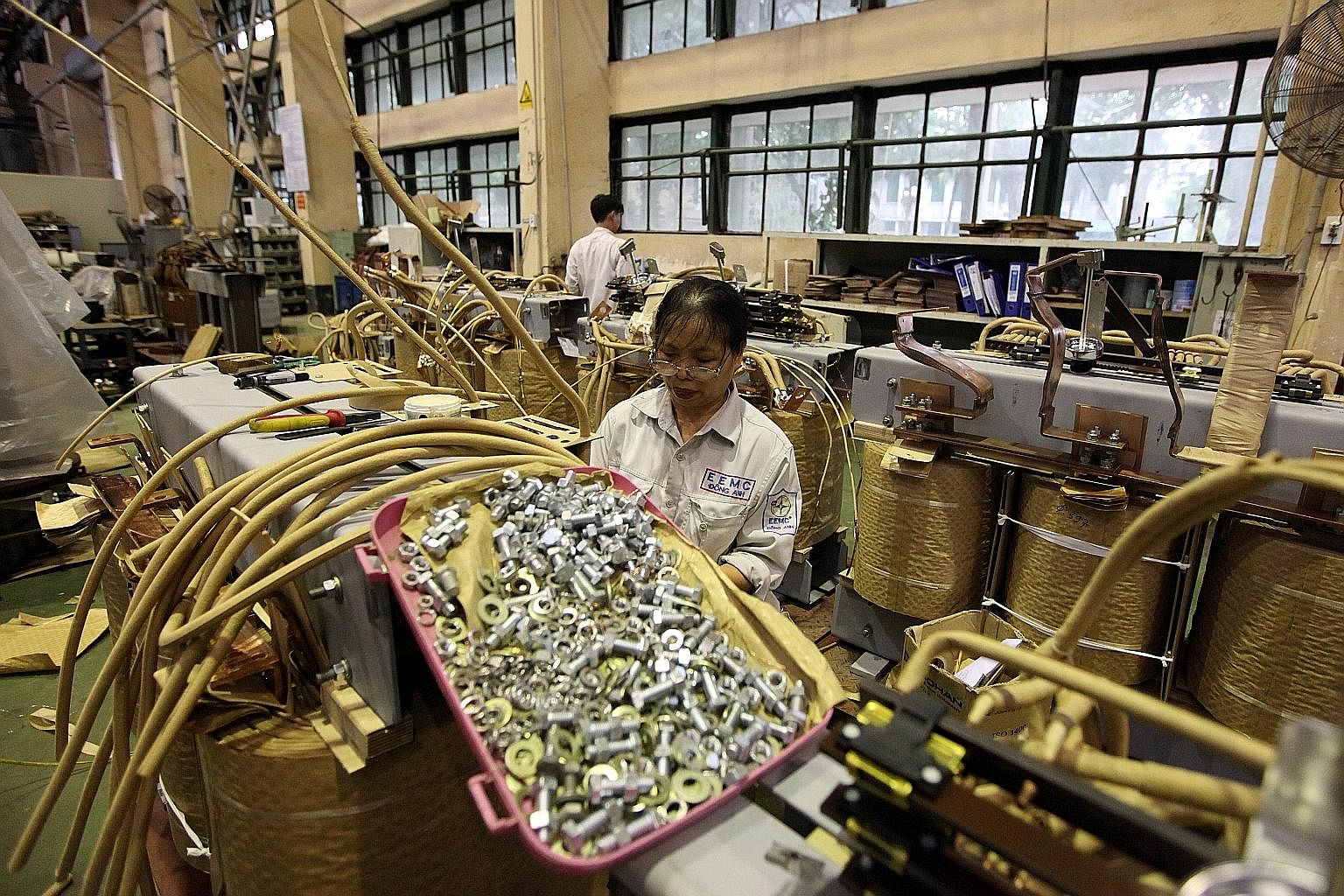HO CHI MINH CITY • At Joy Entertainment in Ho Chi Minh City, the co-founders of the Internet game developer are having a meeting, seated on cushions arranged in a circle on the floor.
The firm's top game, designed by people whose average age is 22, has been downloaded more than two million times globally.
Across town, Ticketbox develops software platforms to sell event tickets. The start-up is just 20m from an office of the local People's Committee of the Communist Party of Vietnam, yet it is entrepreneurial capitalism at its best, and has just expanded to Thailand and Myanmar.
For these vibrant Net-based start-ups, free trade agreements mean little. Their world is already borderless.
For the rest of Vietnam's wider economy, and its bureaucracy, free trade is more of a challenge. Businesses and the government are scrambling to implement the changes required by the advent on Jan 1, 2016, of the Asean Economic Community (AEC), which aims to create a single market for the 10-nation Asean grouping.

Observers say much of the private sector is not ready for the AEC and many firms have yet to grasp the realities of what the new regional market will mean in terms of opportunities and increased competition.
The AEC will transform Asean into a single market and production base characterised by free flow of goods, services and investments, as well as freer flow of capital and skills, Asean says on its Invest in Asean website. "Rather than having 10 fragmented economies, Asean is creating a single market that will allow investors to increase their market reach to a total of 600 million," it adds.
The AEC and the US-driven Trans-Pacific Partnership (TPP) trade agreement which Vietnam is due to sign up to are expected to boost the economy.
Prime Minister Nguyen Tan Dung has ordered all line ministries to set targets and benchmarks on logistics and trade facilitation for the AEC, says Mr Nguyen Thanh Binh, director of the Business Information Centre of the Vietnam Chamber of Commerce and Industry (VCCI). A national coordination committee has been established to set and review targets.
On Sept 8, Mr Dung activated a system to reduce the time taken by clearance procedures. It will be linked to the Asean Single Window, the media reported. The single window is an initiative aimed at speeding up cargo clearance.
At an interview in his office in Ho Chi Minh City, Mr Binh showed The Straits Times Vietnam's AEC compliance "score card" - which reveals the country has implemented almost 66 per cent of all the measures required to comply with the AEC.
This covers a plethora of rules and regulations, from tariffs to health and quality standards, spread across multiple ministries and agencies.
Vietnam's economy has grown rapidly since political and economic reforms were launched in 1986, transforming the war-torn country from one of the poorest with per capita income below US$100, to a lower-middle-income country with per capita income of more than US$2,000 (S$2,840). Manufacturing, agriculture and, increasingly, services are major pillars.
It is the seventh-largest economy in Asean. In foreign investment, Vietnam places fifth, drawing US$9 billion in 2013 - just behind Thailand.
Its gross domestic product grew 6.28 per cent in the first half of this year - about twice Thailand's rate. A study predicts that growth in Vietnam will average 5.3 per cent a year through 2050.
Telephone sets and components are Vietnam's top exports, hitting US$23.6 billion last year. Next were textiles and garments at US$20.95 billion, followed by electronics, computers and accessories at US$11.4 billion, and footwear at US$10.34 billion.
The largest share of its exports - 19 per cent - goes to the United States, followed by 18 per cent to the European Union.
But as a bloc, Asean is its biggest trade partner, with two-way trade last year standing at US$42.08 billion.
Despite the economy's strong focus on external trade, the private sector is struggling with the concept of the AEC. Even at the VCCI, which counts 10,000 companies nationwide as its members, Mr Binh, asked which specific industrial sectors in Vietnam would benefit from the AEC, said: "It is difficult to say. We still need to properly recognise the benefits and advantages."
It was easier to say which sectors may be threatened by the lowering of barriers to goods, services and labour.
"We lack skilled labour, we are short of professionals, especially in the service sectors like banking and accounting," Mr Binh said.
One reason for the ambivalence of the private sector is that Vietnam's manufacturing and export sector has traditionally focused on the US and European markets. A bilateral trade agreement with the US came into force in 2001, and last month it signed a free trade agreement with the European Union.
Now the focus is the TPP, Mr Binh said, adding that the AEC will require a long period of adjustment.
The chamber has been pushing awareness of the AEC at seminars for its members. There is still an information gap, Mr Binh said.
The government, too, is also increasingly preoccupied with a major political exercise: the Vietnamese Communist Party's 12th Congress will convene in January 2016 to renew the nation's leadership.
"Vietnam is in a little bit of a political trench at the moment," said Mr Jeff McLean, managing director of UPS' Vietnam and South Asian operations.
Mr Gian Tu Trung, 41, started Pace Institute of Management in Ho Chi Minh City in 2001. It has trained upwards of 45,000 business leaders so far - and has brought marketing and economics gurus including Michael Porter, Philip Kotler and Paul Krugman to Vietnam to talk about competitiveness.
But lately, he has been focusing on one message, which he delivers across the country at a constant stream of seminars. Get your heads around it, he told his audience. Come the AEC, your home is no longer just Vietnam.
"Singapore, Malaysia, the Philippines, Brunei, Thailand, in terms of trading and investment, are no longer foreign countries. Asean is your home," he told them.
But he also has faith in the sort of entrepreneurial spirit that has lifted Vietnam's economy over the past two decades. "The AEC is more of a reality than the TPP," he said.
"I do believe (the Vietnamese business sector) will change very fast when they realise what is happening," added Mr Trung.
And poised to take the most advantage is the younger generation. For the first time, universities this year began teaching students about Asean.
Ms Nguyen Tran Phi Yen, at 28 the CEO of her own career counselling company and a lecturer at Vietnam National University, teaches a compulsory chapter on the AEC.
"The students are not really aware of how big the Asean market is," she said in an interview.
"We take them on exchange tours to Myanmar and Cambodia. They come back wanting to do better - to learn better English , for example...
"I talk with my students, about how they will be able to travel around Asean and find business partners. And I am optimistic. They have very strong entrepreneurial dreams."
- S.E.A. View is a weekly column on South-east Asian affairs.

